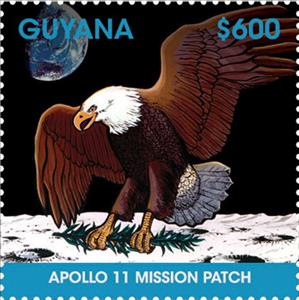Stamp: Apollo 11 Mission Patch Showing Eagle (Guyana 2018)
Apollo 11 Mission Patch Showing Eagle (Guyana 2018)
20 November (Guyana ) within release 50th Anniversary of the First Moon Landing goes into circulation Stamp Apollo 11 Mission Patch Showing Eagle face value 600 Guyanese dollar
| Stamp Apollo 11 Mission Patch Showing Eagle in catalogues | |
|---|---|
| Michel: | Mi: GY 9559 |
| Stamp Number: | Sn: GY 4592b |
| Colnect codes: | Col: GY 2018.11.20-8b |
Stamp is square format.
Stamp from souvenir sheet Footnoted in: Stanley Gibbons Perforation: '13¾' for Stamp NumberAlso in the issue 50th Anniversary of the First Moon Landing:
- Souvenir Sheet - 50th Anniversary of the First Moonlanding face value 1,200;
- Mini Sheet - 50th Anniversary of the First Moonlanding face value 1,650;
- Stamp - Apollo 11 Lunar Plaque face value 600;
- Stamp - Apollo 11 Mission Patch Showing Eagle face value 600;
- Stamp - Astronaut Buzz Aldrin face value 200;
- Stamp - Astronaut Buzz Aldrin Descending Ladder from Eagle onto Moo… face value 300;
- Stamp - Astronaut Buzz Aldrin Walking on Moon face value 350;
- Stamp - The Eagle in Space face value 250;
- Stamp - The Earth from Space, 1969 face value 150;
- Stamp - The Moon from Space, 1969 face value 400;
Stamp Apollo 11 Mission Patch Showing Eagle it reflects the thematic directions:
Animals are multicellular, eukaryotic organisms of the kingdom Animalia (also called Metazoa). All animals are motile, meaning they can move spontaneously and independently, at some point in their lives. Their body plan eventually becomes fixed as they develop, although some undergo a process of metamorphosis later on in their lives. All animals are heterotrophs: they must ingest other organisms or their products for sustenance.
Birds of prey or predatory birds, also known as raptors, are hypercarnivorous bird species that actively hunt and feed on other vertebrates (mainly mammals, reptiles and smaller birds). In addition to speed and strength, these predators have keen eyesight for detecting prey from a distance or during flight, strong feet with sharp talons for grasping or killing prey, and powerful, curved beaks for tearing off flesh. Although predatory birds primarily hunt live prey, many species (such as fish eagles, vultures and condors) also scavenge and eat carrion
Eagle is the common name for the golden eagle, bald eagle, and other birds of prey in the family Accipitridae. Eagles belong to several groups of genera, some of which are closely related. True eagles comprise the genus Aquila. Most of the 68 species of eagles are from Eurasia and Africa. Outside this area, just 14 species can be found—two in North America, nine in Central and South America, and three in Australia.
The Moon is Earth's only natural satellite. It orbits at an average distance of 384,400 km (238,900 mi), about 30 times the diameter of Earth. Tidal forces between Earth and the Moon have over time synchronized the Moon's orbital period (lunar month) with its rotation period (lunar day) at 29.5 Earth days, causing the same side of the Moon to always face Earth. The Moon's gravitational pull – and to a lesser extent, the Sun's – are the main drivers of Earth's tides.
Outer space (or simply space) is the expanse that exists beyond Earth's atmosphere and between celestial bodies. It contains ultra-low levels of particle densities, constituting a near-perfect vacuum of predominantly hydrogen and helium plasma, permeated by electromagnetic radiation, cosmic rays, neutrinos, magnetic fields and dust. The baseline temperature of outer space, as set by the background radiation from the Big Bang, is 2.7 kelvins (−270 °C; −455 °F)





